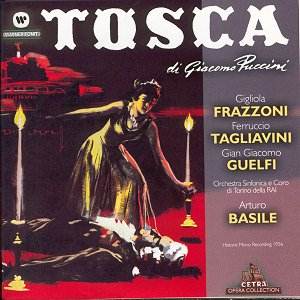The trouble with Fonit-Cetra LPs in the past was their
impossibly shrill sound and poor pressings, with the result that they
tended not to be taken in very serious consideration except for the
rarer Italian operas which were unavailable elsewhere. I should add
that I am speaking in general, not having heard the original of this
particular set, but I am sure that some very good work has been done
here. The forwardness of the voices remains endemic, but they are finely
recorded with excellent presence and considerable dynamic range. And,
if the orchestra is a little further behind than we would want today,
it is in itself remarkably clear in even the strongest passages, and
allows us to hear real Puccinian dolcezza in the softer moments.
This recording now turns out to be as good as most others of its period,
and I might add that it seemed even better on headphones.
The name which will first attract opera buffs is that
of the tenor. Born in 1913, Tagliavini made his debut in Bohème
in Florence in 1938 and established himself rapidly after the war, appearing
at the Metropolitan in 1948 and Covent Garden in 1950. In 1956 he was
at the height of his career (he retired in 1970). Though considered
above all a tenore di grazia, he shows plenty of heft for a big
Puccini role, the voice always firm and ringing, while he finds memorably
honeyed tones for Qual occhio (Act I is generally notable for
the lyricism it finds in odd moments sometimes passed over) as well
as O dolci baci (during E lucevan le stelle) and the beginning
of the duet O dolci mani. Since Tagliavini does not limit himself
to singing the part exceedingly well, but is thoroughly inside it too,
this is a performance which connoisseurs will need to have.
They will also be glad to have a rare recorded performances
by Frazzoni, one of the several casualties of the total dominance of
Callas on the Italian scene at the time she was making her career. Gigliola
Frazzoni was born in 1927, is, as far as I can discover, happily still
with us, and had made her La Scala debut in Andrea Chénier the
year before this recording. She was noted for her Puccini and made a
particular speciality of Minnie in La Fanciulla del West. The
1958 Decca recording might have been hers, for the original plan had
been to record it in Milan under Antonino Votto, following performances
in which Frazzoni had appeared, with Del Monaco and Corelli alternating
as Rance. However, Decca policy was to record all Italian operas automatically
with Tebaldi and, irritated at Votto’s insistence on Frazzoni, recorded
the work in Rome under Franco Capuana. (Votto was not Tebaldi’s greatest
admirer; sometimes, while conducting her in the theatre, he could be
seen surreptitiously stroking his chin, an Italian gesture which means
"What a bore!").
Frazzoni’s voice has plenty of the right body for the
part, but above all she is right inside it, notably perceptive in the
alternating moods of jealousy and trusting love in the first act, and
fully equal to the demands, vocal and psychological, of the second and
third.
Gian Giacomo Guelfi has a fine resonant voice. He is
not as plainly malevolent as some Scarpias, but nor is he mannered;
it is an excellent traditional assumption. I have listed the singers
of two smaller parts, Angelotti and the Sacrestan, because one is immediately
struck in their opening scene, as so often in a native Italian production,
how much these little parts can contribute when well sung by singers
fully able to give weight and meaning to their words.
The Italian Radio orchestras (of which only one now
remains) have not always been world-beaters, but that of Turin, during
Mario Rossi’s heyday in the 1950s, was the exception. Furthermore, in
Arturo Basile they have a conductor in the Italian mainstream which
seems to have died out with Gavazzeni. He catches the right ebb and
flow, finds sweetness without indulgence, gives everyone space to sing
their part without letting things become heavy, and shapes each act
with a firm hand. Basile (1914-1968) worked regularly with the Italian
Radio orchestras both in operatic and symphonic works and died in a
car crash at no great age.
I have kept comparisons out of it so far, for this
is a fine set with which to get to know the opera. However, I can hardly
avoid mentioning that the Callas/Di Stefano/Gobbi/De Sabata recording
of 1953, produced by Walter Legge, is one of the all-time great recordings.
But, is it such a good idea to have only the classics on our
shelves? If you don’t insist on state of the art sound, this one is
probably as good as any other before or since. You must have the Callas/De
Sabata, of course, but there are plenty of reasons for having this one
as well. Danilo Prefumo’s useful note gets an English translation but
the libretto is in Italian only.
Christopher Howell


